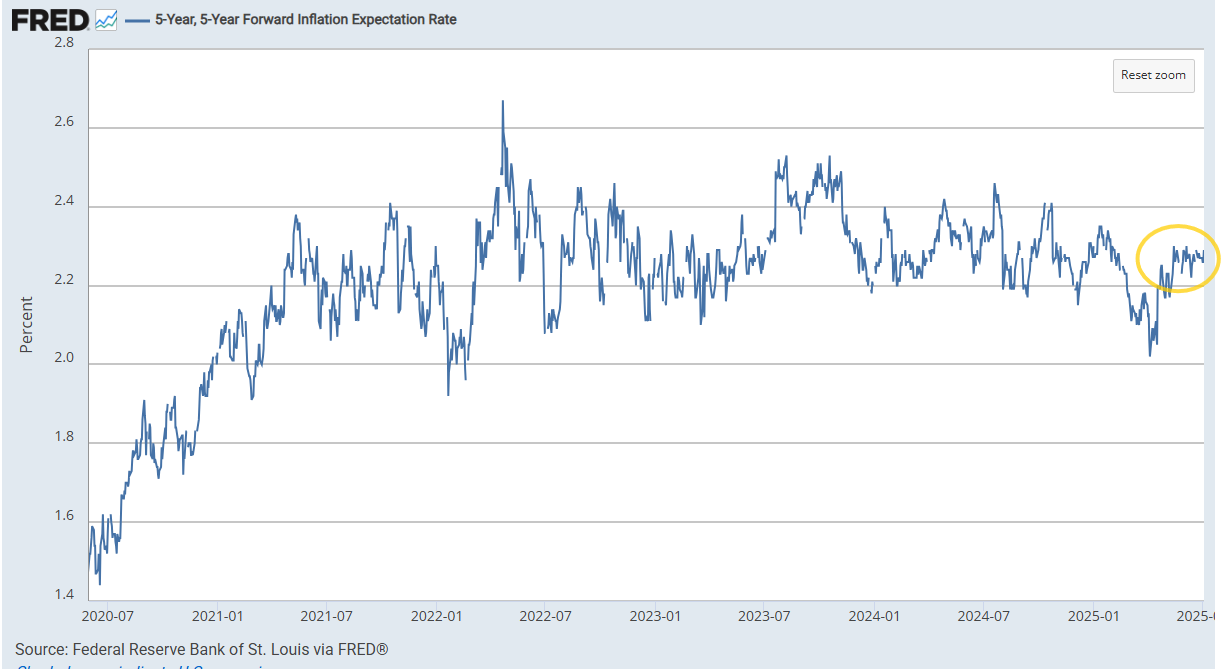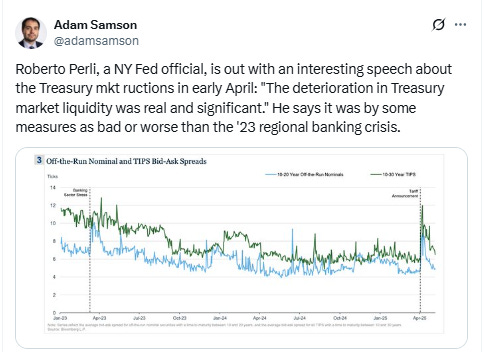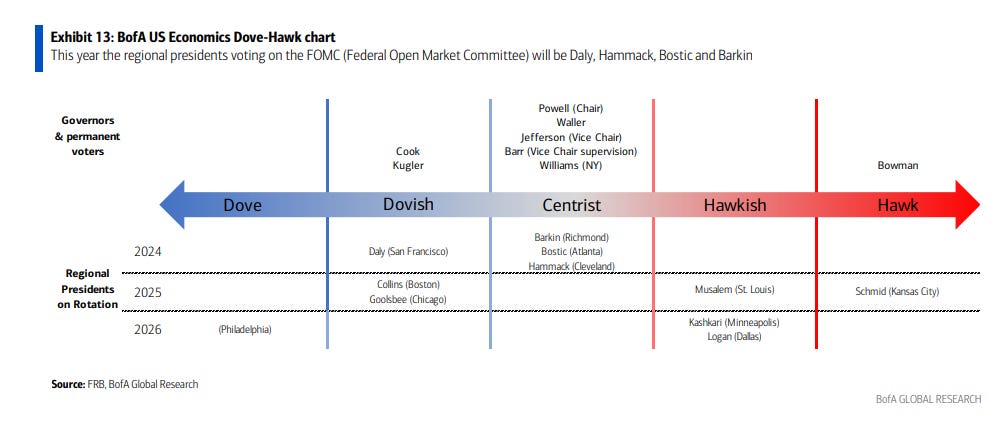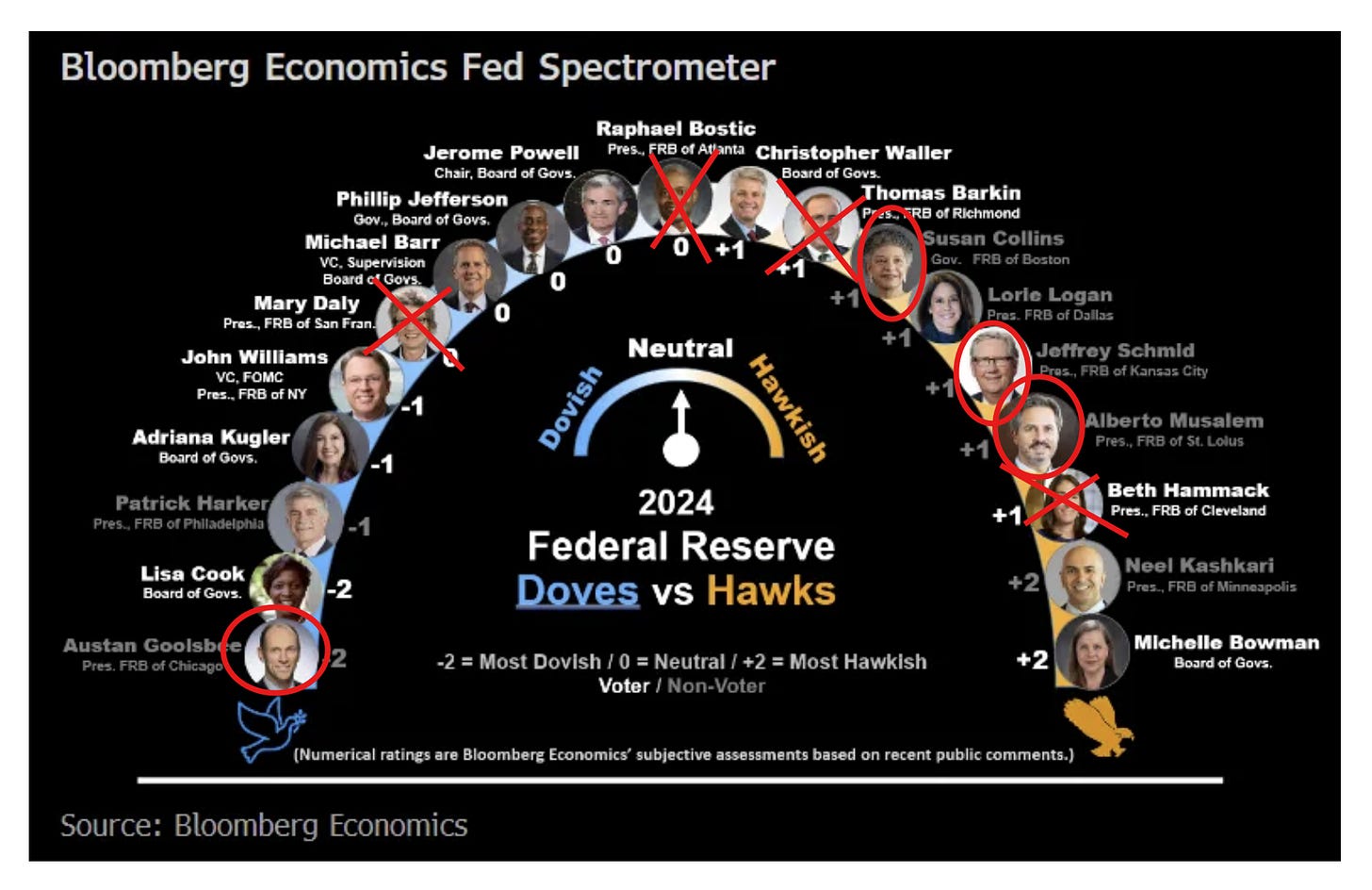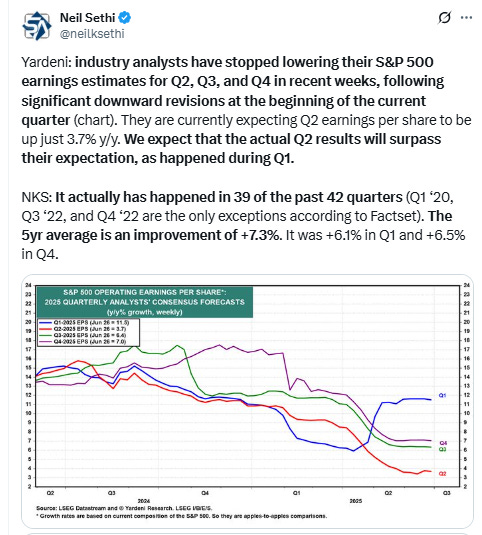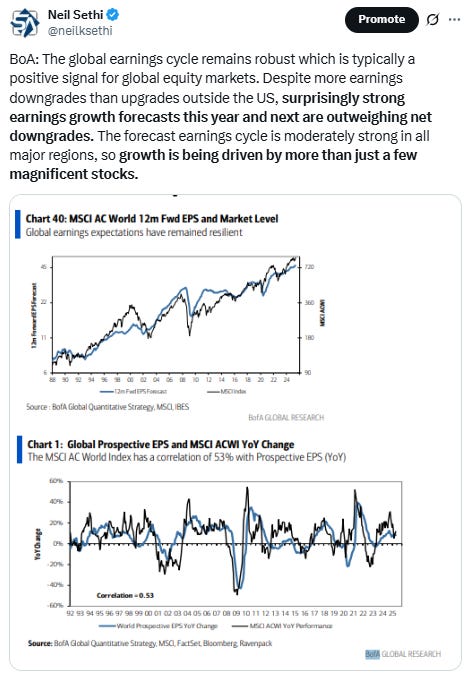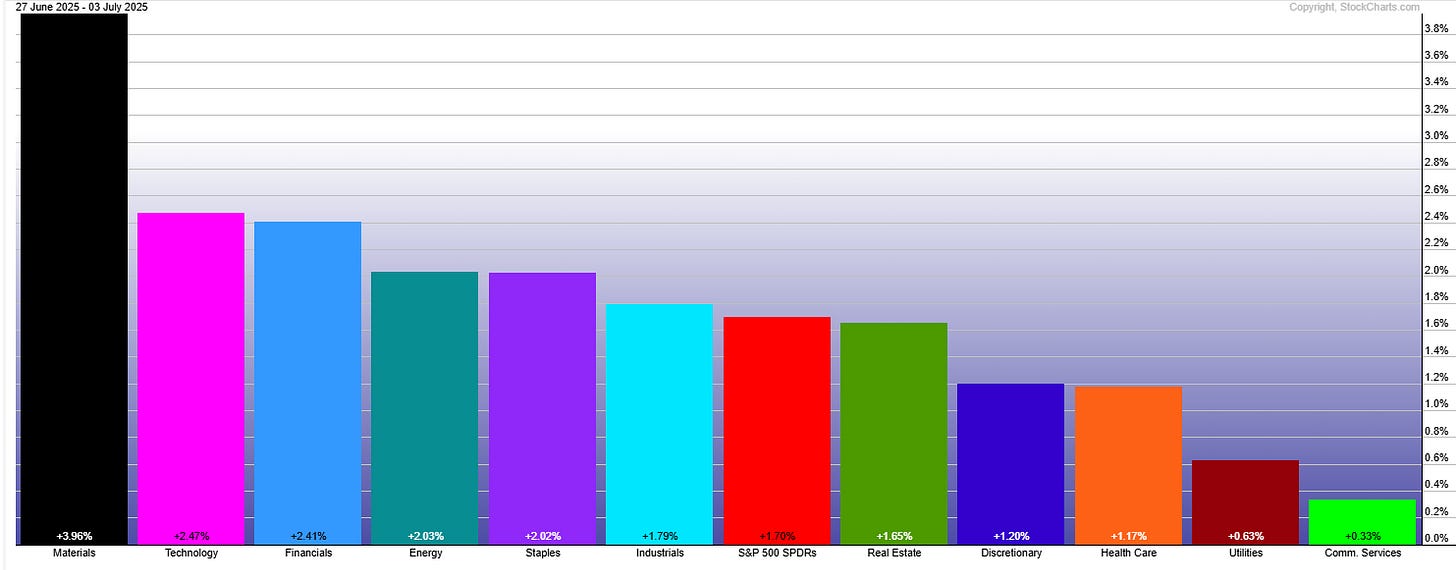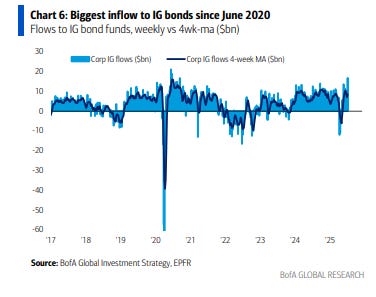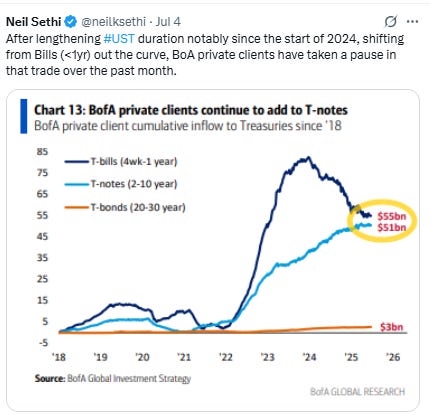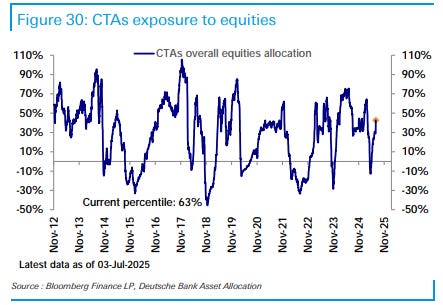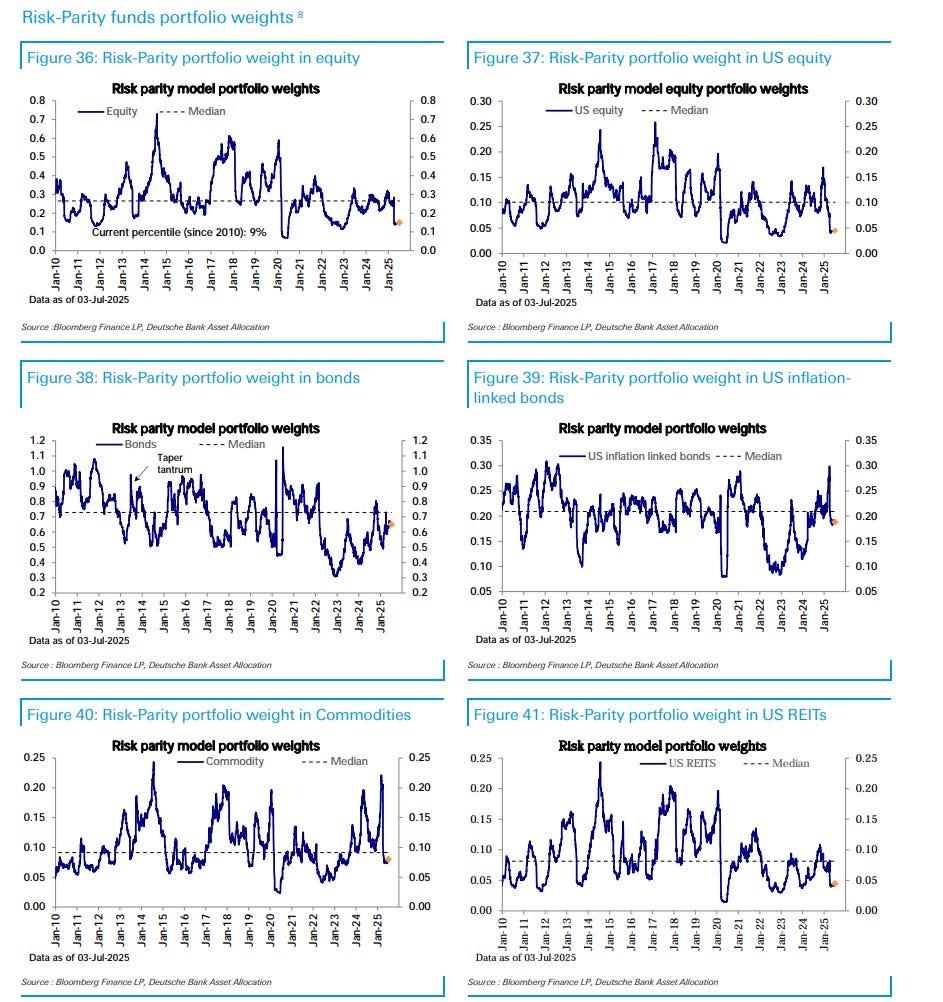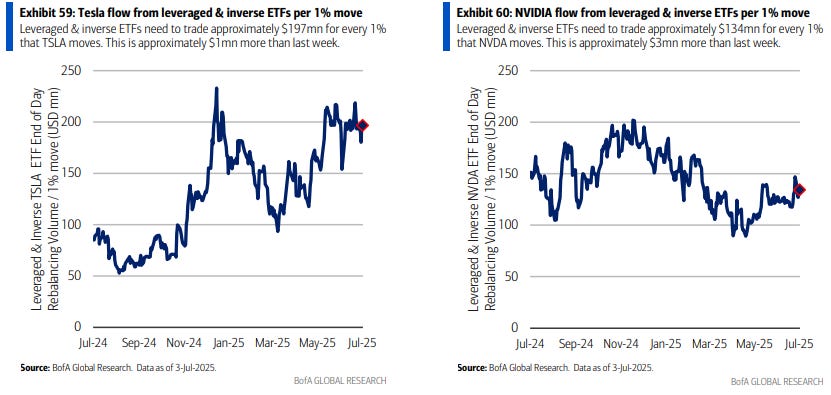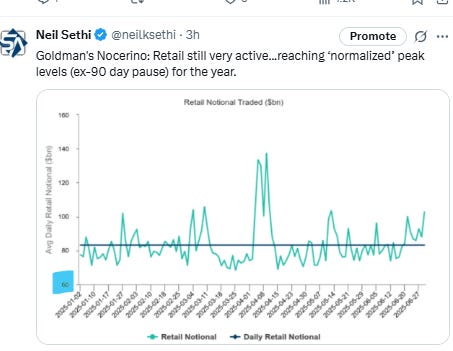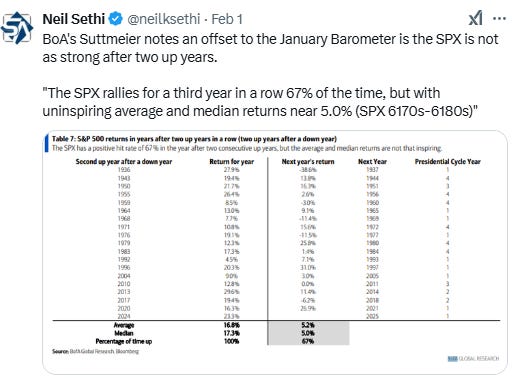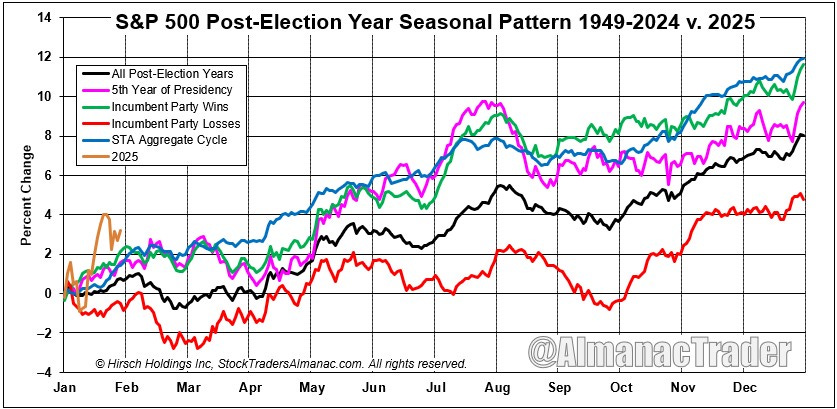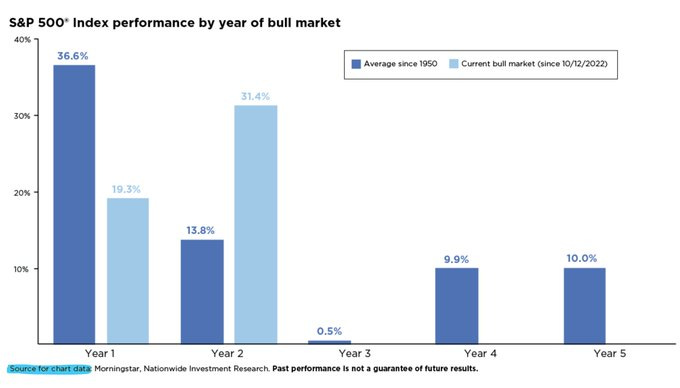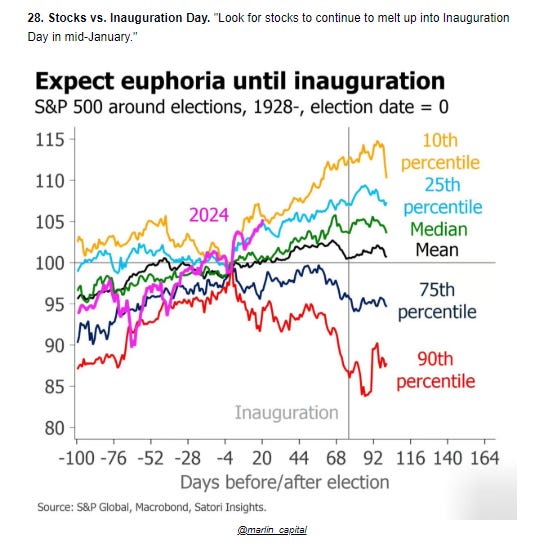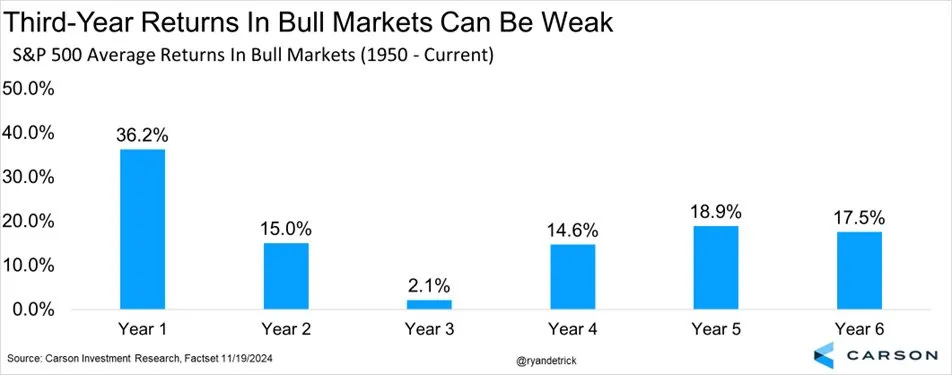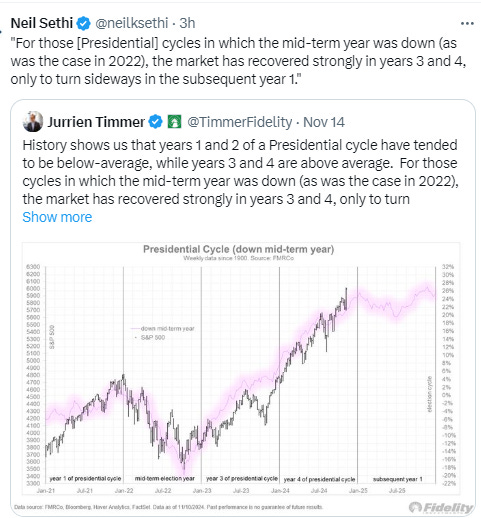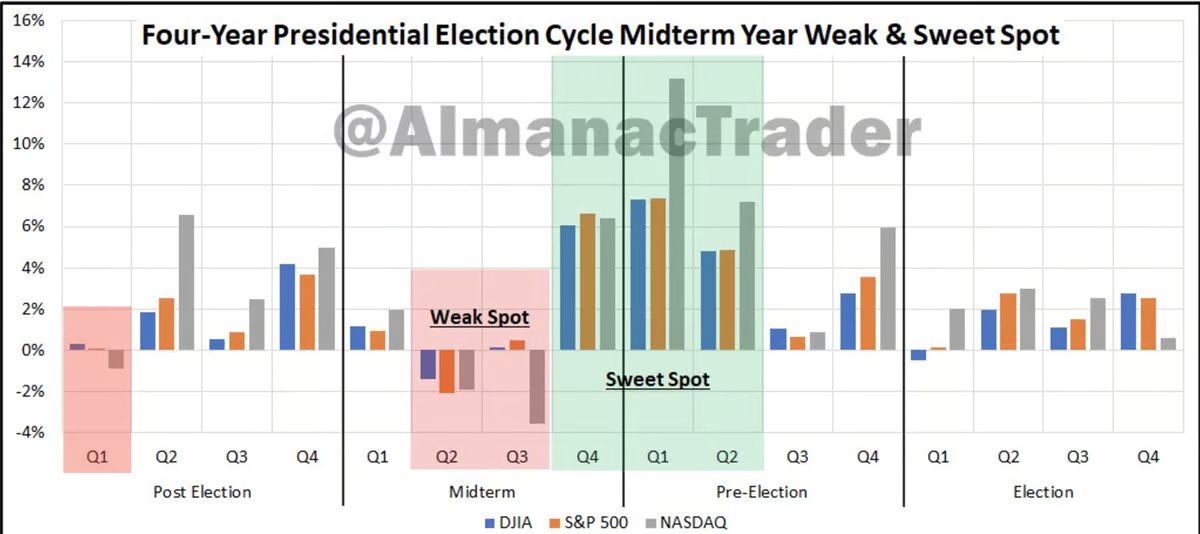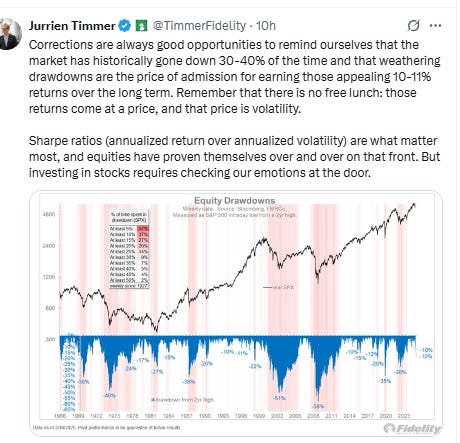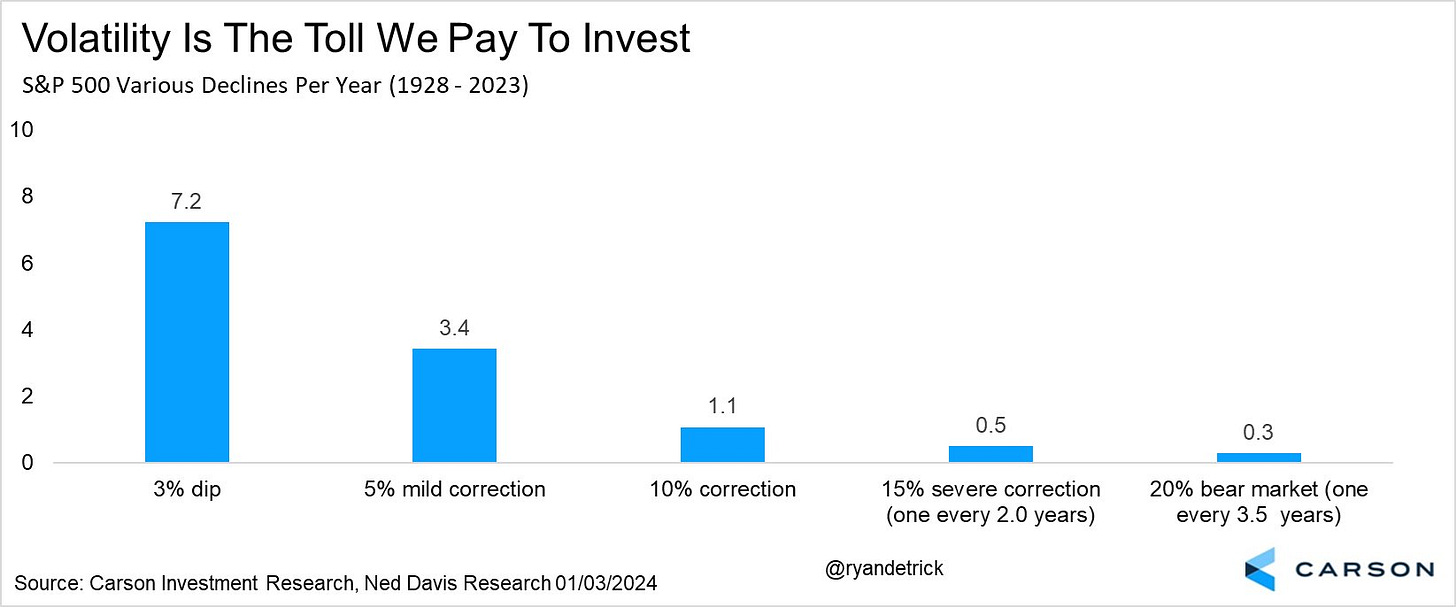The Week Ahead - 7/6/25
A comprehensive look at the upcoming week for US economics, equities and fixed income
If you're a new reader or maybe one who doesn’t make it to the end feel free to take a second to subscribe now. It’s free!
Or please take a moment to invite others who might be interested to check it out.
Also please note that I do often add to or tweak items after first publishing, so it’s always safest to read it from the website where it will have any updates.
As a reminder, some things I leave in from prior weeks for reference purposes, because it’s in-between updates, it provides background information, etc.. Anything not updated this week is in italics. As always apologize for typos, errors, etc., as there’s a lot here, and I don’t really have time to do a thorough double-check.
For new subscribers, this is a relatively long post. The intent is to cover the same areas each week. Sometimes the various areas are more interesting, sometimes less, but it’s easier just to go through them all, so you can expect this format (with things in the same places) each week.
The main sections are intended to cover 1) what’s upcoming next week, 2) what the Fed and rates are up to, 3) what’s going on with earnings (which along with valuations are the most important determinants to stock prices over the long term), 4) what’s going on with the economy (both because of its impact on our daily lives (I am a business investor in my “real” job) but also because it impacts earnings), 5) valuations, 6) breadth (which gets into sector/style performance), 7) positioning/flows (this is the most important determinant to asset price changes in the short term), 8) sentiment (really only matters at extremes though), 9) seasonality (gives you an idea of what normally happens), 10) “Final Thoughts” (remember you get what you pay for there, and it’s the last thing I do so it often is a bit rushed), and 11) my portfolio (to be transparent about where my money is in the market (but note first it is most definitely not intended as financial advice, and second as I mentioned earlier my main job (and investing assets) are in private industries (RE & venture capital)) so my portfolio is built with that in mind (i.e., it’s not how I pay the day-to-day bills)).
The Week Ahead
The upcoming week is the second week of the month, but strangely we won’t get our normal second week of the month US economic reports (which focus on inflation), as many of those (particularly CPI & PPI) have shifted into the third week this month (which is packed, so take advantage of the light week).
In the upcoming week we’ll just get reads on consumer and small biz sentiment, consumer credit, and the standard weekly reports (jobless claims, mortgage applications, and petroleum and nat gas inventories).
Fed calendar is currently light, but I’m sure there will be more appearances than what is listed. We will also get the June FOMC meeting minutes which will be parsed as normal, but as I’ve indicated previously with the amount of Fed speaking engagements we have now there is much less to be gleaned than there used to be. Still, remember, they are “managed” to provide the messaging the Fed wants to convey from the meeting, so they’re important for that reason alone.
Treasury auctions pick up though with the benchmark 10-yr and closely watched 30-yr on Wed & Thurs. We’ll also get a 3-yr on Tuesday.
Earnings pick up but only because there were almost none last week. This, though, is the last light week before we get to the unofficial start of 2Q earnings with JP Morgan on the 15th. This week we have 3 SPX components reporting in Delta (DAL) & Conagra (CAG) on Thursday and Pepsi (PEP) on Friday.
And of course there will be plenty of news from Washington to keep us occupied most of it likely surrounding the July 9th expiration of the 90-day reciprocal tariff pause on Wednesday. President Trump said on Friday letters were going out setting tariff rates for some countries as of Aug 1st, and hopefully there will be some trade deals announced. I would imagine there will be some (many) extensions of the pause as well.
Note earnings date listed listed is one day in advance for some reason. From WallStNumbers.com.
Ex-US the Trump tariff drama will be the predominate concern, but putting that aside, the highlights are Canada employment, China inflation, UK GDP, the BoE financial stability report, Germany industrial production, EU finance ministers meeting where they are expected to finalize the admission of Bulgaria into the EU, and inflation numbers from four of Lat Am’s five largest economies along with central bank decisions from Australia, New Zealand, South Korea among others.
Canada
In Canada, figures for June are likely to show a further weakening of the labor market after the unemployment rate ticked up to 7% the previous month. Tariffs are curbing businesses’ appetite to hire, especially in manufacturing and other trade-exposed sectors. A report on return arrivals to the country in June is expected to reveal a continued decline in cross-border tourism.
Asia
The week is packed with central bank decisions and key macro indicators that will help define the region’s second-half trajectory. Monetary policy takes center stage in Australia, New Zealand, South Korea and Malaysia, where officials are expected to weigh recent inflation trends against slowing growth momentum. Meanwhile, China’s inflation will offer fresh clues on the region’s manufacturing pulse and domestic demand conditions, after Vietnam on Saturday reported a surprise surge in growth.
The Reserve Bank of Australia is expected to lower its cash rate to 3.6% on Tuesday, marking a third consecutive cut as inflation eases. The decision will be preceded by the NAB business confidence survey and ANZ job ads, both of which will help assess how sentiment and hiring intentions are tracking. On Wednesday, the Reserve Bank of New Zealand is expected to keep its policy rate unchanged at 3.25%, while Malaysia’s Bank Negara is anticipated to hold its overnight policy rate steady on Wednesday. A day later, the Bank of Korea is seen holding the base rate at 2.50% as it weighs the case for buffering the economy from the impact of Trump’s tariffs against a desire to avoid fueling soaring housing prices in the capital.
China releases inflation data on Wednesday, with price pressures likely to remain subdued, while loans and money supply indicators will be closely watched during the week. Japan publishes labor cash earnings on Monday as policymakers look for indications that rising pay is feeding into demand-led price gains. Bank lending, current account figures and the Eco Watchers Survey are also due. Elsewhere, the Philippines publishes its employment report for May, Taiwan releases June CPI and trade data, and Indonesia updates on foreign reserves and consumer confidence.
Europe, Middle East, Africa
Among this week’s highlights, UK GDP for May will be released on Friday, with a small increase predicted by economists after a drop in April that was the biggest drop since 2023. The Bank of England publishes its latest financial stability report on Wednesday, with a press conference presented by Governor Andrew Bailey.
Manufacturing-related data from around the euro zone showing the impact of Trump’s tariff policies will draw attention following Friday’s release showing a much-bigger-than-anticipated drop in German factory orders in May. That country’s industrial production numbers are due on Monday, followed on Tuesday by exports both there and in France. Output in Italy will be revealed on Wednesday. Fewer European Central Bank appearances are scheduled, but Bundesbank President Joachim Nagel and Executive Board member Piero Cipollone will be among them. Eurozone finance ministers will meet at the start of the week, with the agenda to include the exchange rate at which Bulgaria is supposed switch to the euro. Officials are also set to seal legislative acts to finalize that country’s new membership of the single currency starting in January.
Turning to the Nordics, Swedish inflation is due on Monday, followed by house price numbers on Tuesday and the monthly GDP indicator on Wednesday. That’s also when Norway and Denmark publish consumer-price data. Russian policymakers will watch for evidence that inflation is continuing to ease when June numbers are published on Wednesday. The Bank of Russia cited slowing price growth in its decision to cut borrowing costs last month for the first time in nearly three years. Deputy Governor Alexey Zabotkin said inflation data will influence whether officials consider a larger than one percentage-point cut in the key rate at its July meeting. A few monetary meetings are scheduled throughout the wider region:
Israel’s central bank is set to hold rates for a 12th consecutive time, with policymakers waiting to see if inflation returns to the target range after the shekel rally that followed a ceasefire with Iran.
Romania’s decision on Tuesday and is expected to see borrowing costs on hold, with officials concerned that recent fiscal changes may trigger a new spike in inflation and dampen economic growth.
Serbian policymakers will reveal their decision on Thursday after keeping the rate unchanged at 5.75% since September.
The same day, Egypt’s central bank decision is due following two cuts in as many months, aimed at boosting economic growth. Inflation accelerated for a third month in May, potentially giving the officials pause before lowering the deposit rate from its current 24%.
Latin America
It’s inflation week in Latin America, with four of the region’s five major economies set to publish price data for June. Colombia kicks off proceedings on Monday, with expectations that annual inflation slowed below 5% for the month. That would mark the lowest reading since October 2021, although price increases remain above the central bank’s target range. Chile’s data on Tuesday is expected to show little change or perhaps a slight uptick in annual inflation from May, when consumer prices rose 4.4%. While that too remains above the central bank’s target, policymakers signaled last month that they may soon resume monetary easing if global economic uncertainty remains limited.
Mexico will release inflation data on Wednesday, a day before policymakers publish the minutes of their decision to cut rates by a half-point for the fourth consecutive time in late June. Analysts expect consumer-price increases to cool slightly, to 4.3%, from May. The minutes will offer clues into how they view headwinds facing an economy that narrowly missed tipping into recession early this year, and provide more hints on the likely pace of future easing.
Brazil, the region’s largest economy, publishes its data on Thursday, with Bloomberg Economics forecasting that it will mark the first breach of the country’s new continuous inflation target. The central bank hiked rates again last month in an attempt to tamp down inflation that ran above 5% in May. Peru’s policymakers will hold their latest rate decision Wednesday, with Bloomberg Economics expecting a quarter-point cut, to 4.25%, after they held steady at their last meeting.
BoA cheat sheets for this week.
Day-by-day calendar from DB (not posted yet):
And here’s calendars of 2025 major central bank meetings.
Market Drivers
So let’s go through the list of items that I think are most important to the direction of equity markets:
Fed/Bonds
As noted previously this was one of the sections that had grown unwieldy, so I’ve really pared it down. Given I provide daily updates on Fed expectations, Fedspeak, and analyst thoughts on the Fed, it’s duplicative (and time consuming) to regather it all, so, again, I encourage you to look at those (the daily posts) for updates. I will just give more of a quick summary.
I’ve taken out the background information from how we got to where we were from the start of the year through the end of March, but if you’re interested you can find that in this section from the March 23rd update.
As I have been noting the month or so leading up to the June Fed meeting two weeks ago ,
there have been some differences in how Fed members are looking forward, particularly into the second half. While many think there’s a low probability for rate cuts this year absent a serious deterioration in the labor market (regional Fed Presidents Schmid and Musalem have even talked about “leaning against” potential inflation consequences (i.e., putting rate hikes on the table (although Schmid was not so aggressive in his last appearance)) or perhaps a chance for one (Bostic), others are more constructive led by Governor Waller. Mary Daly continues to think two cuts are a “base case,” while Goolsbee is back looking for “much lower rates” in 10-16 months.
Another place there is some difference is in how Fed members think they should respond to a situation where inflation is sticky or increasing while the labor market is weak. As noted Schmid and Musalem, joined recently by Dallas Fed President Logan (not a voter this year) and Gov Kugler (who provided a very detailed analysis of her thinking (see the Friday update) would not be cutting, and NY Fed President Williams, a key voice, insinuated recently that in the event of a tradeoff between the Fed’s inflation and growth goals, they should pick fighting inflation.
So as I said 7 weeks ago,
it seems for now the markets probably have it right that the Fed is going to wait until we get deeper into the year and some of the “uncertainty” has hopefully passed (or at least we’ve had a longer run of time with tariffs in place) regardless of what happens with inflation (i.e., they are going to “look through” any cool prints for now). They also will look through high prints focusing on market-based measures of long term inflation expectations. The only thing it seems that would get them to move would be a deterioration in the labor markets.
But I noted 4 weeks ago:
I have a feeling if inflation continues to remain relatively subdued (it was basically at the 2% target in April (so Powell did get his “soft landing”)) that more members will climb on board. That said, there is certainly no rate cut coming at the meeting next week, and given we’ll only get one more set of inflation and NFP reports by July, it seems the market may be correct in September being the most likely next cut.
And as noted last week
we did see more members “climb on board” with Waller, most notably Michelle Bowman, although that was as much her “throwing her hat in the ring” as a potential Fed chair. And while Daly and Goolsbee continued their constructive tones seeing two rate cuts this year (and Kashkari (who is not a voter this year) did the same, a large contingent came out more hawkish led by Powell, although outside of the very hawkish wing (basically Schmid and Hammack who are clearly in the no cuts this year camp and perhaps Musalem) there has been a softening in the tone as Fed members “mark to market” their statements (i.e., inflation at least at the consumer level has remained tame).
I thought Powell did a better job this week (than at the June FOMC where I was critical of his performance) in his Congressional testimony in being more balanced and acknowledging that there was certainly a path where tariffs result in moderate and/or “one time” price rises that would clear the way for rate cuts later this year. In that regard he said that with all of the uncertainty, he thought “any of” the potential inflation paths that were being forecasted by Fed members were reasonable. Importantly, both Powell as well as other Fed members say they are expecting to see tariff impacts “in the summer” and Powell specifically pointed to the June and July inflation reports (to be delivered in July and August) as key inputs.
Given all of that, I think it’s now pretty clear that if we get through August with no notable tariff impacts that the Fed will be cutting in September and likely again in December (assuming things continue towards the 2% target). Of course, we could always see a quicker start to the cutting cycle if we see a sharp rise in unemployment (I think above 4.5%) or growth really starts to deteriorate (we did see some very weak data on the spending side this week, although it’s hard to say how much was tariff “hangover”. There even remains the outlier possibility that if we get a weak employment report (and other economic data) over the next several weeks and still soft inflation we could see July become “in play”.
And it did seem that last possibility (a July rate cut becoming “in play”) was on the table after the weak ADP number, but a strong top line read in the employer’s payroll number (ignoring that it was mostly state/local education hires (so probably a seasonal adjustment issue)) along with a decline in the unemployment rate (even if it was because of a falling labor force) seemed to take the wind out of the sails of a potential cut this month. Without another NFP report between now and then, I think it’s fairly safe to say if the FOMC does anything, it would be to “tee up” a potential Sept cut if inflation remains tame than to move this month. You never know of course, but if a cut is coming this month, it will without a doubt be messaged ahead of time via one of the “Fed Whisperers”.
We’ll be getting a lot of data between July and September, and I think it’s safe to say that if it continues to come in consistent with readings the past few months, a cut is coming in September.
And that’s consistent with what we saw in FOMC pricing on Friday:
And with Fed rate cut bets edging lower after NFP the 2/10 curve pushed back down to +0.58% remaining in its range over the past 3 months.
As a reminder, historically when the 2/10 curve uninverts following a long period of inversion the economy is either in a recession or within a few months of one. It uninverted in Sept, so I had said this looks officially like a "this time is different" situation.
The 3mos/10yr yield curve (considered a better recession signal than 2/10’s w/the last four recessions on average coming a few months after the curve uninverted (prior to that it generally uninverted after a recession had already started)) fell to the least since early Apr on Monday at -0.17% before recovering to -0.07%, still clearly calling for rate cuts (this is normally closer to 1.25%).
As noted back in February, this (reinverting) is something that it did prior to (or just after) the last two recessions and it also dipped (but didn’t reinvert) in the two recessions prior to that. Not sure if the reinversion “restarts the clock” on the recession watch. If so the longest it went in those previous four instances before recession after reinverting is 6 months (2007).
Also note that in 1989 and 2007 we saw similar periods of a recovery from inversion that stalled at the zero line for long periods of time which turned into recessions after they lifted (but in 1989 it took six months).
And another way of looking at this, the 10yr Treasury yield continues to fluctuate around the Fed Funds rate, well under the typical spread of around 1-1.25% above, so also for now still calling for rate cuts.
As noted previously when it’s dropped from above to below (as opposed to having the FFR move from below to above) as it did earlier this year, we’ve always seen a rate cut since 1985 although it can take as long as a year.
Long term inflation expectations as measured by the 5-yr, 5-yr forward rate (exp'd inflation starting in 5 yrs over the following 5 yrs), which continues to be referenced by Fed members (including Jerome Powell (although I don't think he mentioned it at the June meeting)) as evidence for long-term inflation expectations remaining “well anchored,” edged up +4bps w/w to 2.29%, remaining around the middle of its 4-year range, so for now not showing a great deal of concern about longer term pressures from tariffs.
And the 10-yr breakeven rate remains in the middle of its post-2021 range at 2.33%, +4bps w/w.
10yr real rates fell to 1.95% Monday, a 2-mth low, before edging back up to 2.00% on Wednesday, still -34bps from the 2.34% mid-Jan peak (which was the highest since Oct ‘23 (and before that 2007)), but still well above the 2012-2020 peak of 1.12%.
As with 10yr rates implied from market pricing, backing into 10yr real rates using 5-yr, 5-yr forward inflation expectations (subtracted from the 10yr nominal yield) similarly saw them similarly fell to 1.97% as of Monday, the least since October, before recovering to 2.04%, still -41bps from the Jan peak (2.45%). These remain over four times the 2013-2020 average of around 0.5%.
And as a reminder according to BoA the importance of real rates on equity returns has seen the largest increase in the factors they track over the past 5 yrs and explains a larger proportion of stock returns (83% correlation) in their data (to 2006), with the dollar close behind the most correlated (76%) since 2015.
Short-term real yields (Fed Funds - core PCE) fell back to 1.65% in May from 1.75% in Apr (rev’d from 1.81%) which was the highest since October, remaining well under the 2.70% last June, which was the highest since 2007, but above the local low of 1.38% in February. [this gets updated at the end of the month].
Not much relief for small businesses or HELOC borrowers as the real prime rate (inflation adjusted using core PCE) fell just a tenth to 4.82% from 4.92% in Apr although over a percent below the 5.9% high last June, which was the highest since Sep 2007. Still, it remains more than double the 10yr pre-pandemic avg. [this gets updated at the end of the month].
A little surprising to some was the FOMC’s median long run projection for the endpoint of the Fed Funds rate (the “neutral rate”) remaining at 3.0%. That said, note the average moved up to 3.11% from 3.02%, and even at 3% it is the highest since Sep 2018 (but also well below levels prior to that). [this will be updated after the July FOMC].
The ACM model of the 10yr UST term premium (which is solely based on interest rates), continued to ease off now down to +0.64% (-5bps w/w). That’s down from the +0.91% hit on May 21st which was the highest since July 2014 but is still +40bps since Apr 2nd.
The extended discussion on term premium (what it is, why it’s important, etc.), can be found in this section in the Feb 4th Week Ahead.
The MOVE index of expected 30-day Treasury note/bond volatility edged off the lowest levels since February but remains not far from the lowest since Jan ‘22.
Despite overall Treasury volatility edging higher, 30yr mortgage spreads edged lower to 2.40%, -5bps w/w remaining in the middle of the 2.5-2.3% range since last September, well under the 2024 peak of 2.73% and the 37-yr high of 3.1% in June ‘23. But they are still around +60bps above the 2010-2020 avg level. Interestingly, getting spreads back down to those levels is something Treas Sec Bessent commented on this week.
Chicago Fed National Financial Conditions Index and its adjusted counterpart (the latter attempts to remove the correlation between the various indicators due to broad changes in economic conditions), both of which are very comprehensive, each w/105 indicators, in the week through June 27th saw the former hold steady for a second week after falling for the previous 8 weeks at the joint least (loosest) since Jan at -0.50 (revised up a touch), while the latter rose for the first time since early April to -0.47 from the least since February.
https://www.chicagofed.org/research/data/nfci/current-data
Turning to RRP, some background:
As the Fed continues to drain liquidity from the system via QT, I think it’s important to watch for stresses which give an early warning signal that they are perhaps going to far as they did in 2018 which led to a near bear market. One area I am monitoring is reverse repos (which is an overnight secured place institutions (mostly money markets and banks) can park excess funds to accrue some interest, designed by the Fed originally to keep excess liquidity from pulling down rates too much in other short term markets and provide a “risk free” place to park short-term funds). RRP grew rapidly in 2021 & 2022 as money was pumped into the system and needed a home, but since May ‘23 has been steadily drained down by the Fed’s QT program and higher bond issuance with banks discouraged by regulatory rules from taking up the increased Treasury supply.
In particular, the continued sizeable issuance of T-bills (<1 yr duration) of around $800bn/month (accentuated by the $60bn in balance sheet runoff (meaning the Fed has reduced its buying of maturing Treasuries by that amount which the private market has to fill)) drained ~$1.75 trillion from RRP in the year through March 1st. From then until early July RRP levels had remained relatively stable in the $375-$500bn range, but then resumed their decline (in fits and starts (seeing spikes at most month-ends but then coming down to hit new lows), with the lowest level hit Feb 14th at $58bn, the least since Apr ‘21 on the back of the Fed cutting RRP rates to the low end of the Fed Funds band which made parking funds there (versus lending overnight to other institutions or buying T-Bills) less attractive in line with their desire to sop up most of this “excess liquidity” (as they have described it).
As noted in previous weeks, since then RRP had rebuilt as with the Treasury up against the debt ceiling they have had to stop issuing new Treasuries only refinancing maturing ones. This has taken away a source of investment for money markets and other buyers who have had to turn to the RRP in part despite the lower rates. The expectation was for RRP to continue to slowly build until the debt ceiling is raised, at which time (when the debt ceiling is raised) it is predicted to drop quickly as the Treasury “catches up” on the Treasury issuance currently on hold, which will force the end of QT (concerns about that have already seen the Fed cut QT by $20bn), but we saw an unexpected drop in April to a new low ($54bn) Apr 16th, although they have rebounded a bit.
After hitting what I called “concerning” levels Apr 16th at $54bn, the least since 2021, RRP had built back up to around $150bn and remained there outside of May month-end when we saw the typical month end jump as banks shrink their reported balance sheets at quarter/month-end when they have to report their asset mix to regulators (RRP doesn’t count against their regulatory ratios while cash & T-Bills do).
I said “I would expect this to come back down” and it did but as I noted two weeks ago “[w]e should expect to see these same month-end dynamics (which is a little more at quarter end) as move to June 30th,” and that’s what we saw with it actually getting all the way to $460bn, almost to YE ‘24 levels. But as I said a week ago “these should spike Monday and have come back down considerably by the time I report on this next week,” which is what we’ve seen although at $214bn as of Thurs it’s still the highest since April outside of the quarter-end dynamics.
Still expectations were that this would build significantly while the Treasury was drawing down their TGA account (due to the debt ceiling). At this point I’ve completely buried the lead, but now with the debt ceiling raised, the Treasury will refill the TGA which will mean around $400-500bn in extra T-Bill issuance, as it did in 2023 when we faced a similar situation.
Markets had no issues in 2023, but in part that was from RRP funding around $800bn of the rebuild (although there was also full QT happening, and deficits were increasing (they have been flat due to the tariff revenues this time around)). This time around we have nowhere near the same level of RRP cushioning, so I’ll be watching RRP levels (and more importantly bank reserves discussed below) as an early indicator of potential liquidity issues.
In that regard, here is what BoA said earlier this year:
We expect a debt limit resolution in late July/August, which would imply a large TGA rebuild from near $0 following the resolution.... At that time we expect the Fed’s 'dashboard' of money market & liquidity indicators will clearly shift from green, past yellow, and towards red. We continue to believe UST repo is the single best indicator for flagging when QT should end."
RRP is to me most important in its shielding of bank reserves. After touching $3tn in April (which is the level where we saw indigestion in the credit markets in March ‘23 (which contributed to the banking issues (SVB, etc.) and Robert Perli, head of the SOMA desk of the NY Fed confirmed we did see some stresses in April), they had pushed back up to a more comfortable level over the $3tn level where we’ve seen issues in funding markets (this April and March ‘23 most notably). They have declined the past couple of weeks ($3.2tn this week) which is not unusual into quarter end as they shift into RRP and other assets which do not have a risk weighting. But with the TGA being rebuilt, I will be watching reserves closely for potential stresses in funding markets which may mean the Fed has to step in to add liquidity (see RRP discussion).
For background on various estimates of when reserves will be “too low” see the Feb 4th Week Ahead.
Getting back to rates, I said back in April 2024 that 2-year Treasuries were a good buy at 5%, and as I noted once the Fed started its cutting cycle thereafter the ship has likely sailed on seeing those yields anytime soon (meaning years). In terms of 10yr’s I had advised then grabbing some at 4.7% (which I subsequently sold on the drop under 3.75% as posted here in September) but at the time seemed like something we wouldn’t see anytime soon, but we got back there in January (and I added some as posted here) but it seemed like we might be headed much higher until Treas Sec Bessent noted the administration’s focus on keeping the 10yr yield low (and perhaps more importantly committing to the auction schedule set up by Sec Yellen for the foreseeable future (and perhaps even reducing longer term supply per an interview the week of July 1st), which has exerted downward pressure on 10yr yields). I sold that small position on the dip under 4% in April, and it seemed like we were poised to get back up there before they turned down not quite reaching those levels.
And for now we continue to see range bound action in my “2025 likely trading range of between 4 and 5%.” While they left that range in early April (for one day), other than that we’ve been solidly in it, which I expect to continue for now.
I still believe that if we do get a recession with the unemployment rate rising over 4.5%, job losses in the employer’s payroll survey, and contractions in consumer spending and business investment, then we’re likely to see 3.6% again (and probably lower). In terms of how high they could go, I still have a hard time seeing them sustaining for long above 5%.
For all the old “final hike” and “first cut” materials, you can reference the Feb 4th blog post.
Note BoA’s Dove-Hawk chart (which they acknowledge is badly in need of an update) is missing Hammack in ‘26 (Cleveland and Chicago vote every 2 yrs), but otherwise looks right (in terms of voters (also note that Philadelphia Fed Pres' Harker’s replacement has started (Anna Paulson) who will have a vote in 2026). While little is known about how she views policy, she does come from Chicago which is headed by the more dovish leaning Goolsbee (but she’s been there for two decades).
In terms of the Hawk/Dove spectrum it’s still not that far off although Bowman has joined Waller as the most dovish while Kashkari has turned more dovish as well.
While it doesn’t break them across the Hawk/Dove spectrum, UBS had a nice chart this week that gives you voters this year and next. I hadn’t realized that Kugler’s term as a Gov is already up (surprising as those are long).
And I came across one from BBG. I think it’s pretty accurate except Kashkari is definitely not that hawkish (he was calling for a December cut in early November):
And here who is rotating off and on for 2025.
Found another FOMC hawk/dove chart to add to my collection. This one from Barclays. Seems pretty accurate except have to wonder how hawkish Hammack really is considering she was talking about a June rate cut right before the blackout. Also, don't think Daly is all that hawkish given she said she was looking for two cuts this year that week as well.
And on Harker’s replacement in July.
Earnings
As a reminder, I have removed most of the background material, which you can get in the Feb 4th blog post. You can reference this post from 12/1/24 for stats on 3Q, this post from 3/9/25 for stats on 4Q, and this post from 6/1/25 for stats on 1Q 25.
As we head towards Q2 earnings (the unofficial kickoff is July 15th w/JPM who has cemented that role at this point (but we’ve already started to get them as some companies don’t follow the calendar for their quarter-end), we’ve seen a larger than normal drawdown in expectations, now to 5.0% according to Factset from 9.3% as of the start of the quarter (April 1st) although unchanged w/w. This decline is larger than the 5 & 10-year averages (-3.0% & 3.1%).
While the 8th consecutive quarter of positive earnings, it would also be the least y/y growth since Q4 ‘23.
6 of 11 sectors are expected to report y/y growth (Industrials is expected at -0.1% which will likely mean it also will show growth) led by Comm Services & Tech while Energy leads the 5 decliners.
In terms of revenues, Factset says 4.2% growth is expected for Q2, down from 4.7% to start the quarter, which would be the 19th straight quarter of growth.
10/11 sectors are expected to report growth led by Tech. Energy is the lone decliner (but that has been cut in half since the start of the quarter).
In terms of profit margins, expectations are for 12.3% for Q2, down from 12.7% in Q1 but a touch above the 12.2% a year ago and the 5-year average of 11.7%. Two sectors are expected to report a year-over-year increase in their net profit margins in Q2 2025 compared to Q2 2024: Communication Services (14.0% vs. 11.6%) and Information Technology (25.0% vs. 24.0%).
In addition to Q2 being left unchanged this week at +5.0% growth (-4.6% past 13 wks, -8.6% last 23 wks),
-Q3 also was unchanged at +7.3% (-4.4%, -8.1%),
-Q4 at +6.4% (-4.9, -10.3%).
2025 as a whole +9.1% unch w/w for a 6th week.
With Q2-Q4 expectations edging higher, Factset says expectations for 2025 as a whole have stopped slowed their decline, while remaining for now around the least since the start of their tracking at $264.15 (-$10.11 since Dec 31st), they have deteriorated by less than a dollar since mid-May. .
That though still represents a pretty healthy growth rate of +9.1% for 2025 earnings, but that’s also down from 12.6% Dec 31st. Factset says the -3.6% drop in 2025 earnings expectations in the first six months of the year is larger than the 5 & 10yr avgs (-3.4 & -2.4% respectively).
“At the sector level, ten sectors witnessed a decrease in their bottom-up EPS estimate for CY 2025 from December 31 to June 30, led by the Energy (-17.8%) and Materials (-12.0%) sectors. On the other hand, the Communication Services (+2.6%) sector is the only sector that recorded an increase in its bottom-up EPS estimate for CY 2025 during this period.”
In terms of the earnings growth exp’d for 2025 Factset notes it will be a record, although also notes that there is on average over the past 25 yrs a -6.3% deterioration from where it starts the year ($275.05) w/analysts overestimating in 17 of those yrs (which would equate to $257.72 based on the average deterioration). But it should be noted that average includes 4 outlier years (2001, 2008, 2009 & 2020) where the overestimation was b/w 27-43% due to recessions. Excluding those, the difference is just -1.1% (which would equate to $272.02 (above where we are now)).
2025 revenues are now expected to grow +5.0% down -0.8% since Dec 31st, and down from 5.4% at the start of the quarter (April 1st).
Energy is the only sector expected to have negative revenue growth (although that’s been cut by two-thirds since the start of the quarter).
The softening to 2025 earnings expectations (now down to +9.1% y/y growth from over 14% at the start of the year) has been matched by 2026 expectations which have remained near +14% all year (as of Thursday +13.8%, +0.1% since Dec 31st), as they've tracked 2025 lower on an EPS basis.
Factset’s analysis of analyst bottom-up SPX price targets for the next 12 months as of Thursday continued to increase after 6 weeks ago halting a 10 week string of decreases (the longest period of softening since 2022) this week another +15pts w/w to 6,694 (still -347 pts last 16 weeks, but +167 pts past 6 weeks) which would still be +7.5% from Thursday's close.
Health Care (+15.9% down from 16.9% the prior week but up from 14.9% three weeks ago) remains the sector having the largest upside seen by analysts followed by Energy (+13.5% down from 14.9% the prior week (and +20.4% four weeks ago) followed by RE (+12.2% down from +14.4%) while Financials (+3.2% down from +4.6% and +6.2% three weeks ago) and Industrials (+4.2% down from +5.7%) are the sectors expected to see the smallest price increase.
As a reminder the last 20 yrs (through 2024) they have been on avg +6.3% too high from where they start the year (which was 6,755), but note they underestimated it five of the past six years (including 2024).
Factset: In terms of analyst ratings, buy and hold ratings continue to dominate at 56.4% & 38.7% (buy ratings are up from 53.6% on Oct ‘24), while sell ratings edged down to 4.9%.
The Energy (68%), Communication Services (64% (down from 68%)) and Technology (64%) sectors have the highest percentages of Buy ratings, while Consumer Staples (40%) has the lowest percentage. Utilities and Staples lead sell ratings at 7%.
The Consumer Staples (53%) sector also has the highest percentage of Hold ratings.
“The percentage of Buy ratings is above its 5-year (month-end) average of 55.1%. The percentage Hold ratings is below its 5-year (month-end) average of 39.0%. The percentage of Sell ratings is also below its 5-year (month-end) average of 5.9%.”
And some other earnings stuff:
Economy
Over the past 2+ years part of my earnings optimism has been due to the economy holding up better than expected. While earnings only track the economy loosely (and markets look forward 6-12 months), there is a clear positive correlation between the economy and earnings (particularly a weak economy and weak earnings), and there is a very strong correlation between earnings and stock prices (although stock prices (being as noted forward looking) generally fall in advance of a recession and bottom 6-9 months before the end of one). So if you can see a recession coming it is quite helpful, although very difficult (especially ahead of the market). You can reference this Week Ahead (see the Economy section) for a lot of material on how every recession is preceded by talk of a “slowdown” or “soft landing” as close as a month before the start. That report also has the notes about how small caps have shorter debt maturity profiles and more of it (debt).
The intro will remain unchanged for the time being as it serves as introductory material:
As long time readers know the beginning of this section hadn’t changed much until this year since I switched to the Week Ahead format in mid-2022, with the indicators to me during that period consistent with solid (which at times has been robust) economic growth, and I have been a broken record that I “certainly do not think we’re on the verge of a recession (although as noted above every recession starts out looking like just some economic softening).”
Since the end of March though, we’ve seen the data soften (it actually now stretches back pre-March with 1Q services spending getting a notable markdown (as did services exports and construction spending). In terms of more current data while the NFP was a beat at the headline there were plenty of issues under the surface (perhaps the biggest of which was the fact that private payrolls came in at just +74k and total aggregate incomes were flat (the least since last July) and the y/y change was the least since Mar ‘21). Construction spending was also weaker than expected as was ADP and exports. On the more positive side, the services PMIs were better than expected in expansion territory, job openings, quits, and layoffs all were solid, factory orders confirmed the very strong numbers from the initial estimate with solid core capital orders (proxy for biz cap ex), and jobless claims remained low (although continuing claims remained near cycle highs).
So, overall, I would say the data last week continues to show an economy softening but remaining in “ok” shape at this point, but with those “tiny cracks” as I put it three weeks remaining. For now the general message remains the same as prior weeks:
Hopefully we don’t get much further softening and perhaps we can rebound as we start to (fingers crossed) get past the tariff uncertainty. The good news is the important services sector has so far held up which is keeping overall employment and wages up [but as noted we saw some cracks in that this week]. That last item is perhaps the most important indicator to watch (real wage growth). We also got a weak productivity report but for now we can look through it given it was based on faulty GDP metrics. Hopefully once they get that all squared away it comes in better, but that’s another thing to keep an eye on. Productivity is incredibly important in allowing the economy to expand with less labor supply and without triggering inflation. Still, for now, I continue to feel that any softening does not appear to be morphing into a recession.”
And as I said at the start of September:
without question, the evidence is building that the days of >3% real GDP growth are behind us, and we should be happy to settle into something more around trend (1-3% real (infl adjusted) growth). That though is far from a disaster. The important thing will be to see the softening level out (L-shape) rather than continue to fall turning the “soft landing” into a recession.
And looking more specifically at the biggest current risk to economic growth, the tariff policies and uncertainty they’re creating until finalized, as I mentioned 12 weeks ago,
I am now less concerned than I was the week the reciprocal tariffs were first unveiled given we’ve seen a clear acceptance by the administration that they likely overreached and are now dialing things back (including now China) with continued positive noises coming out of the White House regarding “deals”, etc. As I also noted we saw that there is a definite pain threshold for the administration which means to the extent things start to look shaky, we seem to have a “Trump put”, although there are perhaps longer term ramifications that we’ll only see months/years down the road in terms of the global view of the US as an investment destination which may have impacts on the cost of capital here. That’s beyond the scope of this note, though, and as I said following the unveiling of the reciprocal tariffs when I noted I didn’t want to forecast a recession despite the numerous calls for one because “I am not an economic forecaster, so I will just continue to follow the data…. I think it’s too early to draw any strong conclusions,” that remains the case. For now, I don’t see any strong signs of a recession.
My thinking on tariffs will get a big test this week.
Finally, as a reminder, it does appear more and more likely that we’ll be getting some level of economic boost from deregulation and the OBBBA which should at the very least offset the drag we’re getting from the tariffs and restarting of student loan payments and perhaps provide a bigger boost than many are expecting.
Next week is light on data, but the following week we’ll get a lot.
While under the hood some of the data last week was not the greatest, the headline data was pretty good, and the Citi Economic Surprise Index added another +8.1 pts after +13.6pts the prior week to now -2.2, the best in a month, still though down -13.6pts the last 5 weeks).
The highs of the year were 22.5 in mid-Jan. The 2024 high was 47.2 (in Feb) and the low -47.5 (in July).
And GDP estimates are for now consistent with a no recession call (again though remembering GDP going into recessions generally doesn’t look like one is coming (it was up around 2% in Q2 & Q3 2008 well after the recession had started)), and while the Q1 number was weak as I expected, there is broad agreement that it was a function of mismeasurement (even the Fed said that in their May meeting minutes), but it looks like instead of that getting revised higher, it is flowing through to 2Q GDP estimates although many are not seeing the improvement I was expecting with like Q1 the gap now getting quite wide (although at least all positive) going from the St. Louis Fed & NY Fed at less than 2% to Goldman near 4%,
2Q GDP estimate from the Atlanta Fed (whose GDP tracker was right in line in its 3Q & 4Q ‘24 first est’s of GDP (and just a tenth off for 2Q), but who was -1.2% too low for 1Q ‘25) edges up to 2.61% from 2.55% July 1st (which was the least since May 27th) on modest changes to the components.
NY Fed’s 2Q GDP Nowcast (as a reminder, they were way off for 1Q seeing +2.6% vs the actual 1st est of -0.3% (although they were closer in most other estimates and that will be closer after revisions)) continues its steady deterioration now down to 1.56%, the least since it initiated tracking Feb 28th (which was the highest at 2.85%), from 1.72% the prior week (and 2.72% Apr 25th) most notably on the trade numbers (which subtracted -0.17%) as a weak ADP mostly offset the stronger payrolls figure.
As a reminder the model is “dynamic” and so adjusts in real time as data evolves and “parameter revisions” were a notable drag -0.14%.
The NY Fed’s 3Q GDP tracker fell to 1.78% from 1.92% the prior week, also the least since the start of tracking (which was 2.54% May 30th).
St. Louis Fed Q2 GDP tracker (which has had a mixed track record the past few years, often undershooting actual GDP since Q2 ‘22, but was right on in Q1 & Q4 '24, but then way too high at +3.07%(!) for Q1 ‘25), unlike other GDP trackers rebounded this week although from just 1.02% the prior week to a still low 1.32%, but now closer to the NY Fed’s 1.56%. They do not give a breakdown of the inputs.
No update (again) from BoA who can’t seem to get out a US economic update on a holiday week (unlike the rest of the analysts).
BoA (who as a reminder was just a tenth high for 1Q ‘25 GDP vs the 1st estimate, right on for 4Q ‘24 GDP & two tenths high for 3Q), dropped their 2Q GDP tracker to 2.5% as of Thursday due to the larger than expected markdown to 1Q consumer spending (validated by the weak May number Friday), weaker than expected new home sales, exports, offset by the stronger than expected durable goods orders.
Following this week’s data, Goldman’s 2Q GDP tracker drops nine tenths from last Friday to 3.0% (-0.6% on Friday’s data alone), although their estimate of domestic final sales (a measure of underlying growth trends that combines consumer spending and business investment) improved to +07.% from 0%. As a reminder their official house forecast for Q2 is for 3.8%.
We forecast quarterly annualized GDP growth of 3.8% in Q2 (reflecting distortions related to frontloading of imports ahead of tariffs), 0.6% in Q3, and 0.9% inQ4.
The Weekly Econ Index from the Dallas Fed (scaled as y/y rise for GDP (so different than most GDP trackers) which uses 10 daily and weekly economic series), which runs a week behind other GDP trackers, in the week through June 28th fell back to 2.12% from 2.34% the prior week (and down from 2.66% on Apr 19th) moving back towards the middle of the 1.49 - 2.66% range it has occupied for almost all of the past 3+ yrs, only poking above a couple times earlier this year (most recently Apr 5th).
The 13-wk avg also fell back after increasing for the first time since May 3rd the prior week, to 2.26% from 2.27% (remaining off the 2.53% May 3rd, which was the best since 2022), continuing though to evidence overall economic momentum that is a little above trend.
https://www.dallasfed.org/research/wei
Other economy stuff:
Valuations
Like the other sections, I’ll just post current week items regarding the multiple. For the historical stuff, see the Feb 4th blog post.
With equities outpacing the rise in forward 12-mth earnings expectations for the most part, the SPX forward P/E ratio is now pushing towards multi-year peaks and P/Es increased notably for mid & small-caps, although it did edge lower for the "Megacap-8" (which must have seen a significant boost in their earnings expectations):
-The SPX forward P/E is 22.2 (+0.3pts w/w, +3.2pts since Apr 20th and -0.1pts from the post-2021 peak of 22.3 in December.
-Mid-caps' (S&P 400) is 16.3 (+0.4pts w/w, +2.2pts since Apr 13th, -1.2pts from the highest since early-’21 (17.1)).
-Small caps' (S&P 600 so higher quality than the Russell 2000) is 15.6 (+0.4pts w/w, +2.6pts since Apr 13th, and -1.5pts from the highest since early-’21 (17.1)).
-Yardeni's “Megacap-8” (adds NFLX) P/E is 28.6, -0.1pts w/w, +5.4pts since Apr 20th, and -2.9 pts from the 31.5 it hit in 1H 2024 (which was the highest since Jan ‘22)). It was ~31 at the December peak of the BBG Mag-7 index.
https://yardeni.com/charts/stock-market-p-e-ratios/
Other valuation stuff:
Breadth
The NYSE McClellan Summation Index (red line, "what the avg stock is doing") jumped to the highest since Oct breaking out of its sideways move the prior 6 weeks.
The Nasdaq volume-based version (red line) just continues higher has not rolled over and is nearing the highs of the year, which were the highest since early 2021.
SPX new 52-wk highs jumped Thursday to the highest since the start of March and the 10-DMA is as well although well below levels from last year.
% of stocks over 200-DMAs (red line) moved to the highest since February on the NYSE and Nasdaq, a sharp improvement over last week.
% of stocks above 50-DMAs (red line) has seen the NYSE move to the highs of the year (which are the highest since mid-2024 and the Nasdaq is close but not quite there.
While % of stocks above 20-DMAs (red line) are back to the highs of the year on the NYSE, a little under on the Nasdaq.
Hard to see on the chart but SPX growth/value edged back to 2.28 from 2.30 the prior week which was a record high to 1995.
Similarly, the equal-weighted SPX vs cap weighted ratio edged off the joint least (with last July) since 2009, very close to the least since 2003.
IWM:SPY (small caps to large caps) also edged higher in its case to near the highest since March, although still not far from the 24 year lows hit in April.
SPX sector breadth improved to 11 of 11 sectors up on the week (from nine the prior week and give the prior two weeks) led this week led by cyclicals who took four of the top six spots all up by 1.8% of more (Materials led up a big 4%). Tech and Staples round out the top 6.
In total 9 of 11 were up at least 1% (Utilities and Comm Services the only who weren’t).
Stock-by-stock chart from Finviz consistent with a lot more green than red. Far more stocks up more than 4% (including ORCL, APPL, MA, GS, BLK, BA, PEP, CHRT, etc.) than down that much (PLTR, AMD, COIN, ELV, CNC, MOH, WMB, EXE, EQT were all I saw).
Other breadth stuff:
Flows/Positioning
Flows from BoA’s Flow Show report:
ICI data on money market flows saw a +$55.6bn inflow in the week through July 2nd ot a new ATH, in-line with the +$56.4bn EPFR saw. It was 80% from institutions ($43.8bn vs $11.8bn retail) which are ~60% of MMF assets).
Total MMF assets now at $7.08tn,.
https://www.ici.org/research/stats/mmf
Looking at CTA (trend follower) positioning in the US indices, first as noted two weeks ago BoA has updated their reporting to now providing detail on bullish, flat, and bearish price paths (which are based on price trend vs moving averages), and also adds in short, medium, and long term price trends.
With that backdrop they say: “According to our model, short-term trend followers already have meaningful S&P 500, NASDAQ-100, Russell 2000, and Nikkei 225 longs while medium- and long-term models lag with smaller longs or, in the case of Russell 2000, shorts. However, over the next week, these medium- and long-term trend followers are expected to buy across these markets, and this could be significant given that we have shown that most trend followers are somewhere in the medium- to long-term range of model speed”
So BoA sees continued buying (which "could be significant") for the SPX, NDX, and RUT in the upcoming week, particularly on a positive price path.
They don’t have a buy trigger for the SPX but the first sell trigger is 6115 with a second at 5970.
Tier1Alpha’s model also sees CTA positioning in US equities having pushed higher last week requiring further price gains to see them add.
DB notes “CTAs increased their overall equity long positions this week (63rd percentile). In the US, they increased long positions in the S&P 500 (26th percentile) and the Nasdaq 100 (30th percentile) but increased short positions in the Russell 2000 (7th percentile) So CTA positioning remains overall light by their estimates in US indices (heavy though in foreign).
BoA notes on gamma positioning “SPX gamma was unimpressive as of Wednesday’s close at only +$1.7bn (37th 1y %ile). However, the remainder of this past week SPX gamma was a touch more elevated averaging +$3.9bn – not an extreme level but perhaps further evidence gamma may be slowly beginning to exit the muted regime it has endured since late Feb.”
So BoA sees gamma as relatively low but still positive which should have some marginal dampening impact, and it builds on both rallies (but just to 6350 after which there’s a sharp falloff making it more of an accelerant) and declines (to 6025). That should have some pinning effect between those strikes.
BoA continues to model risk parity funds (whose AUM is est’d to be as big as CTAs & vol control combined ($500bn-$1tn)) with their (leveraged) overweight to bonds remaining near the highest since 2021 (although starting to roll over), while their commodity and equity exposures remain low (but continuing to slowly build, at least as to commodities last week).
#oott
DB sees less of an allocation to bonds but otherwise similar (with “very low” equity allocations): “Risk parity funds’ equity allocations largely moved sideways at very low levels (9th percentile) with no notable change in allocations to the US (8th percentile), other developed markets (8th percentile), and EM (26th percentile). Their allocations to bonds (36th percentile), inflation-protected notes (32nd percentile), and commodities (41st percentile) rose slightly..”
With realized volatility having fallen sharply at the 1-mth horizon and continuing to fall at the 3-mth horizon (which should really drop this week (see below)), BOA sees vol control (volatility targeting funds) exposure continuing to slowly rebound but remain off even their lowest positioning of 2024.
They noted last week: “vol control frameworks are likely to continue adding exposure as realized vols decline. However, we note that buying from vol control strategies is typically more gradual than the CTA moves.”
Tier 1 Alpha similar to BoA sees vol control exposure just marginally off the least since 2020 with plenty of room to move higher.
DB as a reminder sees vol control likely to continue to reengage (even as it pulled back to the 30th percentile last week) over the next couple of weeks as the April Liberation Day shock recedes from the 3-mth lookback. Currently they see it at the 56th %ile to 2010 “the highest in four months”.
And after a couple of weeks of vol control modest buying (and selling) we’re now into the meat of the April volatility on the 3-mth realized volatility lookback, with some huge numbers dropping this week including a 9.5%(!) and 6% day. There’s also 4.8, 3.5, 1.8, & 1.6%. That will see the 3-mth lookback realized volatility start to drop like a rock.
The 1-mth lookback remains much less favorable and will likely not provide much buying power (but would provide selling on a jump in volatility). That said, given the drop we’re going to be seeing in realized volatility at the 3-mth lookback this week, we should be seeing a notable increase in vol control buying absent very high volatility.
And Tier1Alpha finds overall systematic positioning continues to recover but remains under the 0 z-score (the mean since 2011).
DB sees it at the 35th %ile since 2010 (up from 24% two weeks ago) and as a reminder a few weeks said it would likely continue to recover through July:
backward-looking vol signals continue to be impacted by the April vol shock and as it recedes from the relevant lookback windows, we expect systematic strategies to continue to raise exposure. Trend signals will also continue to move higher absent a meaningful selloff (at least -2% for the S&P 500).
And as you know, I like to look at the notional value in leveraged ETFs as a barometer of risk appetite, and both the SPX and NDX leveraged ETF positioning continued to shoot higher last week now both the highest since pre-2024.
Remember, this is a “constant negative gamma” source as Charlie McElligott put it in a Oddlots appearance (meaning that there is double/triple buying pressure from them as they rebalance each day). BoA estimates while they’re just 4% of end of day flows for the SPX, they’re 37% for the NDX in the last 5 minutes.
But leveraged ETF AUM in the two largest single stock ETF’s $TSLA and $NVDA were both more subdued with TSLA +$0.2bn to $8.0bn while NVDA was unchanged at $5.9bn, both remaining under (in the case of NVDA well under) the highs of the year.
3rd place $MSTR -138mn to $2.7bn. $PLTR retook the fourth spot from $COIN as the fourth largest at $1.1b vs $1.0bn.
And after buybacks ended 2024 at a record, and started 2025 even better, they had slowed since April but since then they have pushed to new highs (although note we’re deep into the blackout window which runs through July 25th (but that said it only impacts around 30% of buybacks)).
And some other notes on positioning:
Sentiment
Sentiment (which I treat separately from positioning) is one of those things that is generally positive for equities when its above average but not extreme (“it takes bulls to have a bull market”, etc.) and when it’s at extreme lows (“washed out”). I had said in April “I can’t say we’re completely ‘washed out,’ but we’re close.” We’ve now recovered to the point that things are getting a bit frothy. Not sure I’d call them euphoric, but we’re getting there.
AAII bears (those who see lower stock prices in 6 mths) edged back to 40.3% from 41.4% but remain up from 33.6% two weeks ago and above bulls (see higher stock prices in 6 mths) who though rose to 35.1% from 33.2%. 24.7% were neutral from 25.4%.
Those are vs the historical avgs of 37.5% (bulls), 31.0% (bears) & 31.5% (neutral).
NAAIM's (investment managers) exposure index which "represents the average exposure to US Equity markets reported by our members" and which ranges from -200 (2x short) to +200% (2x long) jumped to 99.3, the highest in a year. The 4-wk avg (89) the highest since December.
https://naaim.org/programs/naaim-exposure-index/
The 10-DMA of the equity put/call ratio (black/red line), caught up Thursday like to the sentiment surveys dropping sharply to the least since May and moving towards the lows of the year.
When it’s increasing it normally equates to a consolidation in equities and increase in volatility and vice versa.
The CNN Fear & Greed Index shot to the highest since Mar ‘24 this week at 78 entering “Extreme Greed” for the first time since then. Now 5 of the 7 indicators are in Extreme Greed, none in Fear or Extreme Fear:
Extreme Greed = stock price breadth (McClellan Volume Summation Index); junk bond demand (from Greed); stock price strength (net new 52-week highs) (from Greed); put/call options (5-day put/call options) (from Greed); safe haven demand (20-day difference in stock/bond returns) (from Greed)
Greed = market momentum (SPX vs 125-DMA) (from Neutral)
Neutral = market volatility (VIX & its 50-DMA);
Fear = None
Extreme Fear = None
https://www.cnn.com/markets/fear-and-greed
BofA’s Bull & Bear Indicator (a global metric), up another +0.2pts w/w, now at 6.0 ("Neutral"), “the highest since US election” and further above the 3.2 it hit at the start of the year which was what would now be a 1-yr low. Three of the six components remain “V Bullish” vs just one that is “V Bearish” (HF positioning).
The increase was “on big inflows to bonds (HY & EM), strong global stock index breadth (99th percentile since 2002), robust credit market technicals, offset by weaker equity fund inflows, bearish hedge fund positioning (CFTC data adding protection against lower SPX, stronger JPY).”
Helene Meisler's weekly poll back to bearish for the 3rd time in 4 weeks (and 8th in the past 10) at 48.4% voting next 100pts higher on the SPX (down from 59.1% the prior week).
The high of the year was 72.9% voting higher Apr 13th (a record) and the low was 33.2% on May 17th (also a record).
Helene Meisler’s always fun Weekly ChartFest. Her message this week:
“I suppose today’s theme is that the laggards finally moved while I was away. The contrarian in me has me thinking I should wear this button as we head into mid July.”
It normally includes Citi’s Panic/Euphoria Index which fell almost to the zero line at the end of April but since then has moved higher now back into Euphoria after never getting to Panic.
As a reminder, “[h]istorically...euphoria levels generate a better than 80% of stock probabilities being lower one year later.” In that regard, it first entered euphoria in late March 2024 (when the SPX was around 5200) and then reentered in late October (around 5800). This time (July) the SPX is at 6200.
We didn’t get to 5200 by late March of this year, but we got closer than I would have thought at 5500.
We crossed over 5800 mid-May and haven’t looked back. Seems a stretch at this point to see us under there by October.
That would make it 0-for-2. We’ll see how it does this time (would need to be under 6200 July 2026.
Seasonality
As we move into the first half of July, we enter what since 1950 strongest half month of the year at a nearly 2% median gain. That’s by far the best of all half-month periods.
And we know that looking at July as a whole, in Pres Yr 1 it is one of the strongest months up 67% of the time with an average return of +2.28%, second only to April.
Since 1928 a similar takeaway:
The best average (1.55%) and median (1.92%) gain of all first/last 2-week periods with the 2nd best hit rate (69.1%). Volatility (standard deviation is around the middle of the pack (3.38%, 10th lowest among all periods) although a littl ebelow the 3.5% avg/median.
The only negative is that the average Pres Year 1 peaks in July and falls around -8% by the end of the year from the peak.
As always, though, remember that seasonality is like climate. It gives you an idea of what generally happens, but it is not something to base your decision on whether to bring an umbrella (as the Santa Rally showed us).”
Final Thoughts
I noted at the start of the year,
As we turn the page into the new year, we’re presented with a very different backdrop than what we saw for much of 2024 when the Fed was moving from hiking to cutting, bond yields were falling, seasonality was mostly favorable, systematic positioning was mostly a tailwind, political risk was low, valuations had room to grow, liquidity was very robust, the economy was firing on all cylinders, volatility (until early August) was more subdued, earnings were rebounding, etc.
Now we’re in what is historically a more challenging year (1st year of a Presidential term and 3rd year of a bull market following two 20% years) with valuations well above where we started 2024, high expectations (judging from analyst SPX forecasts), higher volatility and political risk…higher bond yields (particularly real yields), a Fed talking more about fewer than more cuts and continuing to drain liquidity that is now hitting levels we’ve run into issues in the past, high earnings expectations, etc.
It doesn’t mean that we can’t have a good or even a great year. Balance sheets remain very solid as does the economy and labor markets (even if slowing), earnings are expected to be very good, buybacks are expected to be a continued tailwind, there’s a lot of scope for the Fed to become less hawkish, the upcoming administration may provide big tailwinds in tax cuts, deregulation, etc., etc. But we need to see at least some of those come through, and disappointments are not going to be welcomed given the set-up, so my expectation is for choppier markets more like we’ve seen since October than what we saw before.
But 12 weeks ago I noted that I thought
the upside is much more favorable than the downside…. The tariff issue remains the overhang over things and until things are finalized it will weigh on market, consumer, and business sentiment, and prevent any sort of truly sustainable rebound. At some point we’ll get to a resolution that will “free” the markets to react more typically to the other fundamental inputs….. Positively, we did see that Trump will, as expected, not push things too far in terms of stress on financial markets as evidenced by his pivot following stresses in the bond market (which weren’t actually all that bad outside of the move in yields (things barely registered on the Fed’s radar))…the good news is we have taken all of the “froth” out of the equity markets, which means we’ll be working from a much less extended base with plenty of “dry powder” from hedge funds, institutions, etc. And while the Fed is on hold for now, they still have a bias to cut, and the economy (and most importantly labor markets) remain for now healthy.
And then 7 weeks ago,
and things continue to progress better than I think most anyone thought they would, even with institutions still remaining relatively low in positioning as noted in the Flows/Positioning section. As they continue to catch up to the market, it will be an additional boost. Sentiment has turned markedly more bullish but isn’t quite yet what I’d consider a headwind. Earnings expectations have continued to deteriorate, but so far markets haven’t paid much attention. That said, valuations are getting back up towards frothier levels which may present a headwind before too long. Markets can only outrun earnings for so long. The Fed also doesn’t remain particularly friendly to the markets, but again for now stocks have seemed ok with that. We’ve also run a long way in a short period of time, so some consolidation at some point would be expected.
But as I said, “things look far from dire, meaning just as we can’t take for granted this is not a bear market rally, we shouldn’t take for granted this is not going to end up leading to new highs.” … a lot of course also depends on President Trump. The markets have rode a wave of more positive policy (trade deals, progress on tax legislation, etc.), and with Trump saying twice recently it was a good idea to buy stocks, I think we’ve established a “Trump put” at those levels. That said, as I noted last week, “it is just this sort of calm that Pres Trump has in the past sought to use to inject changes in policy, so that’s something to watch out for.” That continues to be the case.
And then six weeks ago
President Trump did take advantage of the equity recovery to inject a broadside against both Apple and the EU (which we’re perhaps seeing to some extent again with Canada), he dialed it back almost immediately, which perhaps indicates as I noted then he’s losing his taste for “pain” associated with the tariffs and is wanting to move along to more market (and politically given the upcoming midterms) friendly items such as tax cuts and deregulation. It seems that escalatory statements now are more to move towards resolution than intended to provide policy guidance. If so, this is a definite market positive. We’ll get a lot more information on that front in the next two weeks. That said, with markets at all-time highs, the likelihood of escalation on his part is definitely higher.
All of which remains relevant as markets continue to ride a succession of positives (a couple of actual trade deals and promises of many more, no real trade escalations, passage of the OBBBA, continued deregulation efforts, etc.) without Pres Trump injecting a major disruption (which gets a big test in the upcoming week).
And while (as I’ve noted the past six weeks) systematic traders (particularly CTAs) and hedge funds have slowly started to bring their positioning back to more neutral levels, equity exposure for the overall systematic universe (especially the large group of volatility targeters including risk parity) and institutions (funds, etc.) remains low historically. This still leaves them in a position that sooner or later they will need to “catch up” if the rally continues and/or volatility continues to die down (and with less to sell if it doesn’t). In that regard, we will almost certainly see a big drop in 3-mth realized volatility this week which should be a boost.
And while we have entered the corporate buyback blackout, corporate flows have remained better than expectations (only discretionary buybacks are impacted), and while retail buying has cooled, it certainly hasn’t turned into major selling, and it seems that “buy the dip” remains as strong as ever.
Valuations continue to be a bit of a headwind, but technicals, sentiment, and seasonality have all turned from less to very favorable (on sentiment perhaps too favorable), and the indices have clearly regained the momentum that appeared to be flagging two weeks ago. Add to that a Fed that seems to be pivoting to cutting rates this year, the tailwind of the Trump tax bill, and an upcoming earnings season which seems from all appearances to be setting up to be any easy beat over beaten down expectations, and the recipe for continued gains seems favorable (almost too favorable).
Just the sort of environment, as mentioned last week, Trump has utilized in the past to “renew escalations” in market unfriendly areas as Deutsche Bank put it. And the economy and corporate earnings could both prove problematic as we move forward, but neither should be expected to this week. Regardless, a consolidation of some sort should be expected. But that certainly doesn’t mean it has to be now.
And in the long term, as always just remember pullbacks/corrections/bear markets are just part of the plan.
Portfolio Notes
Note I shifted some SHY (1-3 yr Treasury ETF) to SGOV on Monday until I figure out what I want to do with it. I also sold down the AGNC position further, now not in top 20.
Cash = 32% (held mostly in SGOV & BOXX (BOXX mimics SGOV but no dividend, all capital appreciation so get long term capital gains if you hold for a year)
Bonds/Fixed Income (mostly short duration like MINT, SHY, ICSH, etc., but also 3% or so in longer term (TLH, TLT)) = 20%
Core equity positions (each 5% or more of portfolio (first 2 around 10% each, total around 25%) Note the core of my portfolio is energy infrastructure, specifically petroleum focused pipelines (weighted towards MLP’s due to the tax advantages). If you want to know more about reasons to own pipeline companies here are a couple of starter articles, but I’m happy to answer questions or steer you in the right direction. https://finance.yahoo.com/news/pipeline-stocks-101-investor-guide-000940473.html; https://www.globalxetfs.com/energy-mlp-insights-u-s-midstream-pipelines-are-still-attractive-and-can-benefit-from-global-catalysts/)
EPD, ET, PAA
Secondary core positions (each at least 1% of portfolio, less than 5%)
ENB
And the rest of the top 20 (all >0.5%, less than 1%):
XOM, GILD, SCHW, ARCC, VNOM, AM, HYD, MPLX, TLH, NEM, IBIT, RRC, PFE, CTRA, ING, AMZN, BOND, VZ, OXY, CMCSA, GAK, CHWY, RHHBY, OWL, VICI, BIP, AR, GPN, FXI, URNM, DVN, SCMB, VOD, GOOGL, SLB, BAYRY, GLD, TLT, O
High quality, less conviction due to valuation
Note: EPD, ET, MPLX, PAA all issue K-1s (PAGP is the same as PAA but with a 1099).
Reminder: I am generally a long term investor (12+ month horizon) but about 20% of my portfolio is more short term oriented (just looking for a retracement of a big move for example). This is probably a little more given the current environment. I do like to get paid while I wait though so I am a sucker for a good well supported dividend. I also supplement that with selling calls and puts. When I sell a stock, I almost always use a 1-2% trailstop. If you don’t know what that is, you can look it up on investopedia. But that allows me to continue to participate in a move if it just keeps going. Sometimes those don’t sell for days. When I sell calls or puts I go out 30-60 days and look to buy back at half price. Rather than monitor them I just put in a GTC order at the half price mark.
To subscribe to these summaries, click below (it’s free).
To invite others to check it out,
























